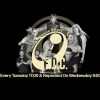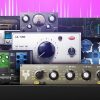-
 play_arrow
play_arrow
Clubalicious Clubalicious Radio
-
 play_arrow
play_arrow
London Calling Podcast Yana Bolder

“So. Central Rain” is one of those songs, like The Clash’s hit “Train in Vain,” where the words in the title don’t actually occur in the song, but you certainly know the song when you hear it. Remember Michael Stipe’s plaintive, powerful voice singing, “I’m sorry…I’m sorry”? Now you remember.
It’s not easy to put a finger on exactly what made R.E.M. so different, so great and so influential when this song became their first full-fledged hit in 1984. They had no gimmicks, no synths, definitely no hairdos and they didn’t even seem that angry. They weren’t retro, and they weren’t punk or new wave either. But they became one of the few bands of the early ’80s that managed to maintain counter-culture credibility despite becoming enormously successful. Their early albums also brought real guitars back to a new wave-weary indie scene, setting the stage for what would later be termed “alternative” music.
The members of R.E.M. met in Athens, Ga. Drummer Bill Berry and bassist Mike Mills were natives who had known each other since high school. A friend introduced this rhythm section to guitarist Peter Buck and vocalist Michael Stipe — college kids who had become friends because Stipe frequented the record store where Buck worked. The foursome began playing psychedelic and punk covers at parties, and in small venues around the Southeast, working on their sound and their chops, and beginning to write their own mysterious, jangly, rocking songs.
The band’s first recordings were made in producer/engineer/guitarist Mitch Easter’s garage studio, called Drive-In, in Winston-Salem, N.C. Easter, the frontman for the band Let’s Active, ran a friendly place that was known as a laid-back, creative center for indie bands all over the East Coast.
“It was a classic little garage studio we had,” Easter says, “but little studios back then mostly had 8-track machines and we had a 2-inch, 16-track machine, which was more bodacious in every way! Punk and new wave scenes were spreading out across the country then, too, and the college radio stations were springing back into action, so all these local bands popped up who wanted to make 45s.
“My studio really came along at the perfect time because all these new bands that were springing up also had this idea that they had inherited the punk scene,” Easter continues. “They liked the idea of a studio that represented the music scene they were in, and my place somehow had that going for it, even beyond the local area. I did a lot of New York bands and Athens bands, including R.E.M.”
R.E.M. recorded the single “Radio Free Europe” with Easter. It was a college radio success that was to be come part of an EP, Chronic Town (all made at Drive-In), which was originally meant for indie release on the local Hib-Tone label. But IRS Records ended up signing the band, and the EP became R.E.M.’s first IRS release. Label reps then set about encouraging R.E.M. to make their first full-length album, but they did not want the musicians to use Drive-In.
“Back then, there were all these notions about equipment,” Easter says. “‘You’ve gotta have this if you’re going to make a real record,’ you know? IRS said that it’s got to be on 24 tracks, but I only had 16 tracks. It was like ‘the more tracks the better,’ so we went to this place called Reflection [in Charlotte, N.C.], which was a hell of a lot better than my garage studio, but we really did it because IRS demanded eight more tracks!” [Laughs]
Reflection certainly had plenty of tracks to offer. Easter recalls that studio owner Wayne Jernigan was also a pro audio dealer at that time and, in particular, an MCI rep. So the main recording gear at the studio included MCI JH24 and JH110 tape machines, and an MCI JH600 console. “It was a really nice console,” Easter says, “with maybe 56 channels and these fabulous light meters — maybe the best light meters anybody ever made! They were about 10 inches tall with a lot of elements in them and the best colors. It was like cosmic radiation was coming out of those things. It probably was! It probably made our hair fall out, but they were really pretty and you could switch them into other things like a spectrum analyzer or a peak meter. Most of the MCI boards had VU meters, but these were just beautiful.”
The band wanted Easter to engineer and produce their first album, but the label had doubts — and, actually, so did Easter. “I was a little intimidated by this,” he recalls. “I’d only been recording bands for like a year. So I asked Don Dixon to help me because I was too much of a pup to go into that big studio by myself!”
Bass player/producer Dixon was already known in the local music scene, having recorded and toured with his own band, Arrogance. He’d worked in Easter’s studio, and he had recorded at Reflection numerous times as a musician.
“I’d been in and out of Reflection for 10 years before we did Murmur,” Dixon says. “It’s a classic large studio of the era with a large main studio space — probably 30 by 50 feet — and one tiny little booth at the end and a bunch of gobos. It had your classic RCA Nashville curved walls, these floor to ceiling half-cylinders that helped disperse the sound. It had a live end and a dead end and curtains around. It also had great old tube mics and a lot of other stuff you needed — a Wurlitzer, a nice B3, good piano, vibes.”
Still, Easter and Dixon lacked the sort of credentials that IRS wanted in a production team for an exciting young band, so they asked for an audition tape, which mercifully passed muster. After that, the band and their producers were largely at liberty to make the album they wanted, which Easter says was meant to be moody and unusual without being overproduced. However, on Murmur, Easter says, “A lot of the recording techniques were still sort of like late-’70s techniques. Bill really liked the idea of recording in a drum booth, even though by the time we did that record, drum booths were totally out of fashion. I thought it was kind of charming that he wanted to do that.”
As a result, the drum sounds on Murmur are fairly tight and small. “I don’t want to use the word ‘disco,’” Dixon says, “but they had that really tight, warm sound, like Memphis soul.”
Murmur, released in 1983 and including a re-recorded version of “Radio Free Europe,” was extremely well-received and the band toured relentlessly to support it. Then in ’84, they went back to Reflection with Easter and Dixon to begin tracking their sophomore album, Reckoning, which includes this month’s “Classic Track,” “So. Central Rain.”
Remixing an R.E.M. Classic for Atmos
Dixon and Easter both recall that the band’s approach to Reckoning was more live performance-oriented than on Murmur.
“We brought the drums out into the big room, and there are much more ambient tones on the drums on Reckoning,” Easter says. “Dixon and I were fans of those more live-type songs that were coming along in the ’80s, and the band was ready for that by then, too.”
Easter says that drum miking on Reckoning was fairly conventional, with the exception of Dixon’s homemade version of Fritz, the binaural dummy head: “We wanted that stereo sound, but we didn’t have the budget for a real one,” Easter says. “But Dixon figured you could make one out of a cardboard box. He would take these 2-inch tape-shipping boxes that held two reels, and it was perfect to cut a slot in it and shove in one of those stereo brackets that holds two mics. He would ram that through the box and draw a nice face on the head.”
“I’d been doing that for a number of years,” Dixon confirms. “We’d use U64s or maybe small-diaphragm AKGs — whatever was handy that had a small diaphragm. We would try to pack it with something so it would be solid. I still do that today. Those tape boxes are scattered all over the world!”
Another factor in the bigger, more ambient drum sounds on Reckoning was the acoustic reverb that the production team created. “Reflection had some old, conventional, big speakers that you could use to play stuff back out into the studio,” Dixon remembers. “I think that the idea was for artists to hear what they did. You don’t see that much anymore, but we used those speakers a lot — just to blast things out into the room — and we’d re-record them with microphones that we put in different places using various compressors.”
Recording to the JH-24 machine at 30 ips, Dixon and Easter tracked every song live, with the other three (gobo’d) bandmembers arranged around Berry’s kit in the main room, though Stipe’s vocals and some guitar solos would be replaced later.
Buck’s beautiful guitar work, which so memorably opens “So. Central Rain,” was captured pretty dry, according to Easter, but did feature the effect of a Scholtz Rockman. “These days, that’s as uncool a piece of gear as you could possibly have,” Easter says with a laugh, “but it was so great for Pete Buck, especially back when he had that really clean tone. We would build up these guitar washes with different sounds. We would start with his amp, then do a direct box with some studio effect, and then we also used that Rockman a lot because it had that built-in, weird compressed sound that is really great for 12-strings or on top of one section.” Easter recalls primarily using Shure SM7 mics on guitars.
Mills’ bass amp was miked with a Neumann FET U47 from eight or so feet away, according to Dixon, who says he spent more time on vocals for Reckoning than on anything else. He often gave Stipe a ride to the studio about noon, and they would sing for a few hours in the quiet studio, replacing scratch vocals from the previous day.
“We had Michael sing into a FET 47 — the transistor version of the famous 47 — and it sounded great. It had a good forwardness about it,” Easter says. “The processing on Michael, the thing that seemed to be the magic formula, was a touch of this thing called the EXR Exciter. It was one of those mystery treble-boosting things, and that gave him a touch of brightness.” Also included in Stipe’s vocal chain were a DeltaLab delay, set to only about 16 milliseconds, and a UREI 1176 compressor.
Dixon says that from the beginning of the Reckoning sessions, IRS Records’ A&R had targeted “So. Central Rain” to be the first single from that album, which also required shooting a video for MTV. However, as Easter explains, “Those guys hated the idea of videos. They thought lip-synching and all that was really stupid.” The band and their label solved this problem by making the video in Reflection Studio during the recording sessions.
“We convinced Michael that it was okay to do a performance video if he was really singing,” says Dixon. So Stipe sang live during the video shoot, while the rest of the band mimed along to the album track behind artfully lit gobos.
Easter and Dixon may be the only non-bandmembers who could discern the difference between Stipe’s emotional vocal on the album track and the live track he recorded for the video. And Stipe’s truly authentic performance on the record and video helped make “So. Central Rain” and Reckoning the band’s first mainstream successes. And in the 25 years since they cut their brilliant albums with Easter and Dixon, R.E.M. have stayed impressively true to their art, in spite of health problems, their own reluctance and the departure of drummer Berry in ’97.
Dixon and Easter have remained friends with the bandmembers and with each other. Dixon garnered further production success after producing The Smithereens in ’86 and says that The Smithereens’ hits probably did even more to ignite his production career than the R.E.M. albums he worked on. Easter finally moved out of his garage in 1999 and opened the purpose-built Fidelatorium Studio. Both producers continue playing and recording in North Carolina and beyond.
“I’m still recording bands, and I’m still playing in them,” Easter says. “The chances of anything I work on becoming as successful as R.E.M. now are certainly remote, but then again they were remote back then. From my perspective, I’m just doing the same thing I’ve always done.”
This article was originally posted in February, 2009.
Written by: Admin
Similar posts
Recent Comments
No comments to show.Featured post

Latest posts
Current show

In Session
Sister Bliss
Sister Bliss is one of the true pioneers of modern dance music and the musical force behind the multi-million selling ionic British band Faithless. Each week, Sister Bliss In Session showcases the world's best new upfront electronic music, spinning world exclusives, a live DJ mix, A List artists and DJs on the phone, and a run down of the taste-making Cool Cuts Chart.
closeUpcoming shows

Finnish Dance Chart
Top 40 Hottest Dance Tracks In Finland
17:00 - 19:00
Made To Move
Jacob Colon
19:00 - 20:00
In Session
Sister Bliss
20:00 - 21:00
Fresh Is Fresh
This Weeks Hottest Releases
21:00 - 00:00
Uplifting Only
Ori Uplift
00:00 - 02:00Chart
Powered by Dee jay promotions visit us












 Invalid license, for more info click here
Invalid license, for more info click here